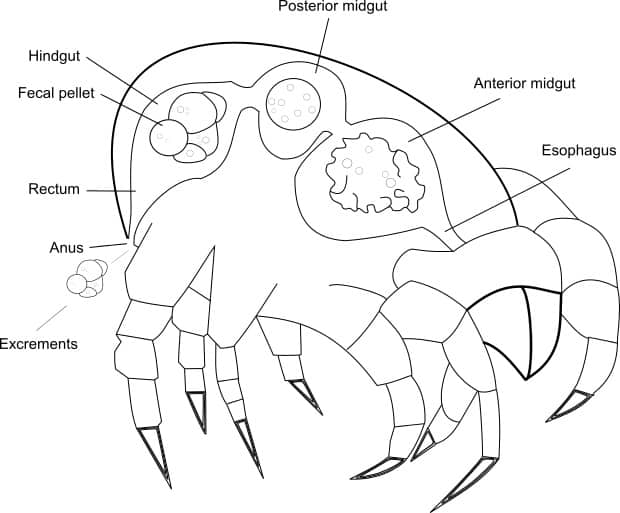House dust mite excrements/ faeces
House dust mites are a major source of allergens and a major contributor to allergic diseases such as asthma, rhinitis, and atopic dermatitis. House dust mite excrements are considered the main source of allergy (1). More than 95% of the allergen accumulating in mite cultures is associated with faecal particles. House dust mite faeces consist of leftover undigested food and digestive enzymes. The house dust mite enzymes digest the large particles in the outer environment of the mite and convert them into future food for the mites. The mites will eat the excrements again and use the digestive proteins from e.g. the skin dander. The mite will then again absorb these nutrients and excrete the excrements supposedly with adding proteins, the strong enzymes. When the excrement has left the body of the house dust mite it will remain intact until it is either eaten by the mite, dissolved upon contact with moisture or simply broken up by disturbance. A healthy mite can produce up to twenty droppings per day.
In the next video you can see a house dust mite leaving a dropping:
Size of house dust mite droppings
The house dust mite excrements are pellets with a diameter of about 10–40 µm. These pellets dry up, decompose into fine dust, float into the air and are inhaled. The size of excrement particles are comparable with an another main source of allergy; Pollen. Each gram of house dust contains approximately 1000 dust mites which each produce daily approximately 20 excrement pellets (2). The small size of the excrements can cause problems for people who are sensitive to house dust mites because the smaller the faecal particle carrying active enzymes, the deeper it can travel into the lungs, even reaching delicate areas of gas exchange. In general, inhaled particles above 10 microns will land on the trachea or bronchi while smaller dust (below 10 microns) has the potential to reach and be deposited in the alveoli. The alveoli is the last stop in the branches of our lungs and where gases are exchanged.
Below an image of processing excrements in the gut of the house dust mite Dermatophagoides pteronyssinus.

The enzymatic activity present in faecal extracts has been shown to play a role in allergic reactions. Proteolytic activity might produce an allergic response when injected into human skin (4).

Image of purified faecal particles, copyright Citeq
Characterization and functional identification of cysteine and serine protease activity and allergens in general, responsible for an allergenic reaction is necessary to understand mechanisms by which mites cause allergic diseases.
Identified allergens in house dust mites
At least twenty allergens have been identified in Dermatophagoides farinae and Dermatophagoides pteronyssinus (4). An increasing number of allergens have been characterized biochemically and some have been recognized as having enzymatic activity. For example, Der p 1 has cysteine protease activity, Der p 3 has serine protease activity, Der p 4 is homologous to amylase, Der p 6 has serine protease activity, Der p 10 is homologous to tropomyosin, Der f 15 and 18 are homologous to chitinase.
| Allergen | Molecular Weight (kDa) | Function |
| Der p1 | 50 | Cystine Protease |
| Der p 2 | 14 | Sterol binding molecule |
| Der p 3 | 25 | Trypsin-like serine protease |
| Der p 4 | 57 | Amylase-like |
| Der p 5 | 17 | Unknown |
| Der p 6 | 25 | Chymotrypsin-like |
| Der p 7 | 22 | Unknown |
| Der p 8 | 25 | Glutathione-S-Transferase |
| Der p 9 | 24 | Collagenase-like |
| Der p 10 | 33 | Tropomyosin |
| Der p 11 | 98 | Paramyosin |
| Der p 12 | 14 | Unknown |
| Der p 13 | 14 | Fatty acid-binding protein |
| Der p 14 | 177 | Vitellogenin |
| Der p 15 | 98 | Chitinase |
| Der p 16 | 55 | Gelsolin-like |
| Der p 17 | 30 | Ca-binding EF protein |
| Der p 18 | 60 | Chitinase |
| Der p 19 | 7 | Anti-microbial peptide |
| Der p 20 | unknown | Arginine Kinase |
| Der p 21 | unknown | Lipid binding protein |
| Der p 22 | unknown | Lipid binding protein |
| Der p 23 | 8 | Unknown |
Der p 23 is an ~8-kDa protein that shows homology to chitin-binding domains and is found mainly in peritrophic membranes surrounding faecal pellets, which are a major source for other HDM allergens (5). Studies performed (6) with purified natural and recombinant HDM allergens identified Der p 1, Der p 2 and Der p 23 are major HDM allergens, with IgE-binding frequencies > 80%; therefore, they must be considered as essential components in vaccines for immunotherapy of HDM allergy.
Ideally, all the enzymatic activity present in mite faecal extracts should be responsible for inducing an allergenic response.
Delivery of excrements for research
We produce and sell purified excrements (purified by hand) from the house dust mites Dermatophagoides pteronyssinus and Dermatophagoides farinae. These mite products are analysed for cysteine and serine protease and will be delivered with a certificate of analysis. Please contact us for more information and pricing.
Literature
- Tovey, E.R., Chapmann, M.D. & Platts-Mills, T.A., Nature 1981 Feb 12;289(5798):592-3.
- Portnoy, J. et al. Ann Allergy Asthma Immunol. 2013 Dec;111(6):465-507.
- Gattuso, J.R., Hales, B.J., Thomas, W.R., Bi, X.Z., Chew, F.T. & Tovey, E.R. JACI February 2005Volume 115, Issue 2, Supplement, Page S91
- Jacquet, A. ISRN Allergy. 2013 Feb 28;2013:735031.
- Weghofer, M. et al. J Immunol. 2013 Apr 1;190(7):3059-67.
- Weghofer, M. et al. Eur. J. Clin. Invest. 2008; 38:959–965
